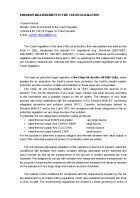Air Monitoring
EMISSION MEASUREMENT IN THE CZECH LEGISLATION
Oct 03 2014
Author: Yvonna Hlínová on behalf of CEM
The Czech legislation in the area of the air protection, that was adopted and entered into force in 2002, transposed the relevant EU regulations (e.g. Directives 2000/76/EC, 2001/80/EC, 2001/81/EC, 99/13/EC, 96/61/EC). In many aspects it follows up the preceding legislation with the foundations being laid in 1991, by adopting the first independent Clean Air Act. Emission measurement, methods and other requirements present significant part in the Czech legislation.
The basic air protection legal regulation is the Clean Air Act (No. 86/2002 Coll.), where besides the air protection, the Earth's ozone layer protection, the Earth's climatic system protection and the execution of state administration in these areas are incorporated.
The Clean Air Act (hereinafter referred to as "Act") categorises the sources of air pollution. They are the categories of very large, large, medium and small sources, according to the importance and a possible impact on the air quality. The category of very large sources was newly established with the transposition of EU Directive 96/61/EC concerning integrated prevention and pollution control (IPPC). Currently, technologies defined by Directive 96/61/EC and by the Czech IPPC Act correspond with those categorised in the air protection legislation as very large sources of air pollution.
To illustrate, the Act categorises combustion plants as follows:
- rated thermal input 50 MW and greater very large source
- rated thermal output from 5 MW to 50MW large source
- rated thermal output from 0.2 to 5 MW medium source
- rated thermal output below 0.2 MW small source,
For the purpose to determine a source category and relevant emission limit value output or input of the individual equipment (boiler) of combustion plant are added.
The Act imposes (stipulates) obligation on the operators of sources of pollution where the compliance with emission limit values, emission ceilings, admissible smoke darkness and odour number as well as the measurement of the amount of emitted pollutants are most important. The obligation to comply with emission limit values and emission measurement for the purpose of checking the compliance with the determined emission limit values is imposed on the operators of very large, large and medium sources of pollution.
The method of and conditions for compliance with the requirements imposed by the Act are determined by its implementing regulations, which were published and entered into force in 2002 as well. The implementing regulations are divided by areas governing in terms of legislation, for instance, ambient air quality standard and evaluation of air quality, the Earth's ozone layer protection conditions; there is also a group of implementing regulations that
determine emission limit values and conditions for the operation of sources of air pollution, being divided by types of technological processes. The individual regulations thus concern combustion plants, hazardous and municipal waste incineration plants and waste coincineration equipment, technologies emitting volatile organic compounds, storage and distribution of petrol and other technologies. Emission limit values defined by these regulations for pollutants that are characteristic of the technologies listed in these regulations are called specific emission limit values.
An independent decree to the Act determines the method of emission measurement and the so-called general emission limit values (Decree of the Ministry of Environment No. 356/02 Coll., hereinafter referred to as Decree). These general emission limit values are then applied to technologies not categorised under the previous implementing regulations and to pollutants for which no specific emission limits have been determined. The basic legislative criterion for the state administration body to determine a general limit value for a certain pollutant with such uncategorised technology is the amount of the emitted pollutant (the annual mass flow).
The operators of sources of air pollution ensure a continuos or discontinuous measurement of emissions for its sources as required by the legislation.
Digital Edition
AET 28.3 September 2024
September 2024
Business News - ENVEA announces acquisition of APAQ Group - SICK and Endress+Hauser sign strategic partnership - Efforts to curb gas flaring intensify amid environmental concerns Air Monito...
View all digital editions
Events
WEATHER • CLIMATE • WATER / EARTH OBSERVATIONS / GREEN ECONOMY
Oct 29 2024 St. Petersburg, Russia
Oct 30 2024 Hong Kong
Nov 05 2024 Toronto, Canada
Nov 05 2024 Rimini, Italy
Nov 06 2024 Ho Chi Minh City, Vietnam















